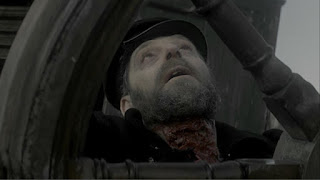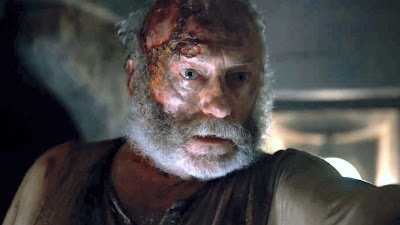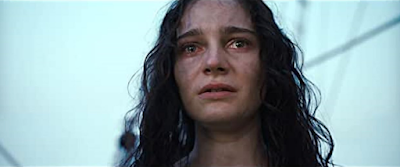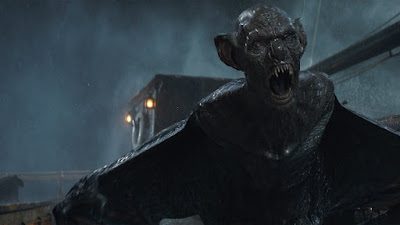I commented on social media last week that I thought you could stage The Last Voyage of the Demeter (2023, directed by André Øvredal) as a play. Find a production of The Pirates of Penzance that's closing and mooch on their sets and you're all ready to go. One of my friends asked if I would make it a musical. I absolutely would. It would be the off-off-Broadway hit of the season. Buy your tickets now.
The story of the Demeter is from Dracula, of course. It occupies chapter seven of Stoker's novel, represented as news clippings pasted into Mina Murray's journal and as the logbook of the ship as reported in those clippings. The Demeter is usually seen at the end of its journey in movies. In the Tod Browning film, the sole survivor is Renfield (he is not on the ship in the book), with Dwight Frye's mad grin staring up at the investigators when the Demeter drifts into harbor. In Murnau's film version, there's an abbreviated version of the voyage. The first still from Nosferatu I ever saw was of Max Schreck standing on the deck of the Demeter. This was years before I ever saw the film. The most indelible version of the Demeter I ever saw was in John Badham's 1979 version of Dracula in which Harker joins the rescuers for the wrecked ship only to discover a man lashed to the wheel with his throat ripped open. A version of this image appears in Jon J. Muth's graphic novel, Dracula, A Symphony In Moonlight and Nightmares. The final voyage of the Demeter from Varna, Bulgaria, to Whitby, United Kingdom is such a vivid part of the Dracula story that it's shocking that no-one has made a film of its voyage until now. It's been, what? A hundred and twenty-six years at this point?
A lot of the imagery from previous versions makes it into this new film, but most of that imagery was already there in Stoker's book. It's a rich novel for interpolations.
The story here begins with the wreck of the Demeter as one finds it in Dracula, and the men who are shaken by what they find on board. The ship's log is intact and offers a dire warning to England if the crew of the Demeter fails against the evil that has come on to their ship. Four weeks earlier, in Varna, the Demeter takes on its cargo and three new crewmen. Among these is Dr. Clemens, a black man who was unable to find employment in England after earning his medical degree. Clemens is initially passed over for the job, but when he saves the life of the Captain's grandson and when one of the new hands freaks out when he sees the crest on the cargo boxes, he's taken on. The captain's grandson, Toby, befriends Clemens and gives him a tour of the ship. Toby has been given responsibility over the ship's livestock. The journey from Varna to London will take several weeks, and that's the meat on board. The ship's mate, Wojchek, doesn't trust Clemens, and the other crewmen range from indifferent to hostile. Things begin to go sour once the Demeter is out of easy range of port. First, all of the livestock die, savaged by some unseen thing. Next, one of the boxes of their mysterious cargo is jostled out of its berth and breaks open. Inside is earth and a woman, near death. Clemens determines that she's lost a lot of blood and gives her a series of transfusions. Then the crew begin to die, one by one. When the stowaway woman wakes up, she tells them that they are all prey to the evil that has dominated her village in Transylvania for centuries. Dracula, she names him. The dwindling crew organize to find this fiend, but it soon becomes clear that if they can't defeat him, they must prevent him from ever reaching London...
Norwegian director André Øvredal has two modes of filmmaking, it seems: He is the maker of eccentric high concept horror movies like Trollhunter and Scary Stories to Tell in the Dark and Mortal. These are films that have a touch of whimsical absurdity to them. He is also the maker of grim, unrelenting horror movies like The Autopsy of Jane Doe and today's specimen. In this mode, Øvredal has an instinct for the jugular that's rare in commercial mid-budget horror movies. That category of film would rather reinforce a nuclear family uber alles ideology than discomfort their audience in any meaningful way. Øvredal has a gleeful disregard of the taboos of middlebrow horror movies. This film does not award any of its characters a plot immunity idol or a hero's death-battle exemption. In the grand tradition of the grindhouse horror of another era, this is a film where anyone can die at any moment. This is entirely appropriate for a story where the audience, if it knows Dracula at all, knows that the Demeter reaches its destination without a crew, save for the man lashed to the helm with his throat ripped open. Everyone on board at the beginning of the journey is a dead man walking. Øvredal and his collaborators oblige the material. They provide the audience with scenes that are every bit as horrific as the R-rating allows.
Which isn't to say they don't take some liberties with the material. They do.
The obvious model for The Last Voyage of the Demeter, per the director himself, is Alien, in which a blue-collar crew must hunt for a monster that is picking them off one by one. And that's fair. A number of scenes are closely analogous, particularly one scene at dinner in which the crew complain about the division of shares for the voyage. Alien is still scary after all these years, and this film manages to capture part of that scariness. But this isn't an Alien rip-off in the traditional sense. There's an element of contagion in this film, too, and of paranoia, both well beyond the singular influence of one film. This is a film that finds many of the trends of contemporary horror movies already there at the roots of the genre. It is particularly concerned with the taboos about death and how we deal with it. In this, there is something of the rawness of Night of the Living Dead. How do we deal with loved ones who become monsters? How do we burn the bodies of those who are close to us without the benefit of a Christian burial? How do we let go? This roots its horror, as Dracula does, in ideas about a bad death and a bad afterlife. It salts this with a dash of eschatology. It's the end of the world for the Demeter. It might be the end of the world for England, should Dracula make landfall.
In spite of its familiarity, this version of the story finds great latitude for storytelling in what scant information Stoker provides. We never know the crew of the Demeter in the literary Dracula or in previous films. We meet them here for the first time. The film adds an interesting wrinkle as to why Dracula has to chow down on the crew (he's deprived of the midnight snack he's smuggled aboard). This version of Dracula is one of the most inhuman versions ever put on screen. There is no romance involved in this Dracula. No glamour whatsoever. He's a monster, full stop, and a terrifying one at that, well beyond the versions in Nosferatu and its remake. We also get as heroes characters who have no idea of how to slay a vampire. Indeed, the word "vampire" is never spoken in the film. There is no Van Helsing character, not even Dr. Clemens, who is an educated man. There is no savant with deep knowledge of the enemy. This puts stresses on the characters that other versions of Dracula don't and adds to their desperation. The scenes all of this generates are striking. The murder of the film's livestock at the outset foretells darker scenes, and the film delivers, whether it's a burial at sea with a victim who isn't quite dead yet, or Dracula alighting on the end of a lifeboat to forestall any attempts to escape him, or the fate of one of the hands who has been bitten and lashed to the mast as the sun comes up, or even the glance of the vampire at our heroes through a broken timbers of a locked door. If a horror film relies on good set-pieces for its scares, then this film has some doozies. The images put on camera here are indelible.
The film also has a conversation with the plight of The Other, though it takes The Other out of the hands of the vampire as allegorical figure and places it with the humans. Clemens is thoroughly distrusted by the crew of the Demeter, both along racial and class lines. Woycheck belittles his book learning as useless for a sailor, though Clemens points out--rightly--that a knowledge of astronomy might be handy for a navigator. It's the color of his skin that puts Clemens outside the circle of the crew, and Clemens has a list of grievances for that that he enumerates in due course. Ana, too, is an outsider, both because of her gender--women were accounted as "unlucky" on ships well into the 20th century, and as a harbinger of the monster. This is a role that is often played by a mad old man (see, for instance, the drunk at the start of The Texas Chain Saw Massacre or the old coot at the start of Friday the 13th), so it's an unusual framing. This is a film that understands the axes of oppression, and suggests that those divisions will destroy us all. Dracula still functions as a political metaphor. A hundred years later, he's no longer the menace of the Russian empire or the unwashed Slavic east (Dracula is a pretty racist text after all), but can rather be viewed as the resurrection of a predatory aristocracy who, having consumed the resources at hand, looks covetously at the West. Dracula doesn't look exactly like Vladimir Putin, but there's a familial resemblance. The book tipped its hand along these lines by naming one of Dracula's victims "Lucy Westenra" or "Light of the West," but this film doesn't need to be that cute.
The producers of The Last Voyage of the Demeter have spent their resources wisely. This is a film that understands that the genre is the star here, and they've cast the film full of familiar character actors rather than springing for movie stars. The ostensible star of the film is Corey Hawkins as Clemens and he's fine in the role. Best of show is probably Liam Cunningham as Captain Elliot, though, who brings the same gravitas and kindness to his character here that he brought to Davos Seaworth in Game of Thrones. He's the moral heart of the film. David Dastmalchian and Aisling Franciosi have less-well developed characters to play. Dastmalichian's character, Woychek, exists as a secondary antagonist for Clemens, while Franciosi's character, Dracula's midnight snack, largely exists to deliver exposition. It's her mouth that first utters the name, Dracula, after all. All of these actors are good even if their parts are often under-written. The concept of the film is the star, here, and the setting. This is an unusually handsome movie that manages the tricky feat of providing environments that are both pleasing to the eye and unassuming enough to not call attention to themselves. It has a lived-in naturalism to it that a more Gothic minded film might exaggerate. Dracula himself is mostly created using practical effects and prosthesis and the benefit of having an object that bounces actual light adds a level of realism to its monster that would escape a monster created in a computer. The filmmakers have gone the Nosferatu road for designing their Dracula, but they've gone beyond Max Schreck or Klaus Kinski and created something entirely devoid of romance or sympathy.
If the film has a flaw, it comes at the end, when we meet Dracula in a London pub. While there is certainly justification in the book for this scene, the way it's framed seems like naked franchise building. It's as if Universal can't get over its dream of launching a "Dark Universe" on the Marvel model. If they had any brains, they would have launched this film in October rather than early August. I'm almost happy that the film isn't doing enough business to reward them for their incompetence. Almost. Because this is a film that really ought to be seen with a receptive audience. When I was walking to the parking lot after the show, I tried to remember the last time a Dracula movie was legitimately scary and came up blank. This film stages scenes that are well beyond the imagination of the vampire cinema of the past. Hammer films only dreamed of making a film this mean.

This blog is supported on Patreon by wonderful subscribers. If you like what I do, please consider pledging your own support. It means the world to me.



























1 comment:
I was initially intrigued by the trailer and thought an entire movie based on this one episode (especially knowing how it ends) was an audacious gamble. But then, the CGI creature was off-putting. For me, the great thing about vampires is that they can mix with us humans and strike when we least expect it. (Of course, there's such a thing as going too far with vampire integration into human society, Twilight's sparkly, romantic teen vampires being a good example.) I would take this concept and have the Demeter crew joined at the last minute by a mysterious, aristocratic stranger who buys his way onto the voyage -- and who knows, maybe he's a red herring and the real Dracula is disguised as one of the crew. And that would be a real box office failure! :)
You're spot on about pretty much every horror offering these days being made with an eye to franchise building, which can tie you up creatively in subtle and not-so-subtle ways. The best thing that can happen to the Universal monsters is for the current mega-corporation to keep failing in trying to build its Dark Universe.
Post a Comment